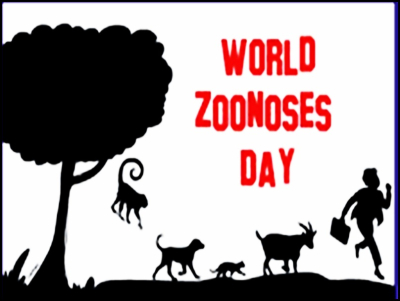
World Zoonoses Day is observed every July 6-a time to examine the invisible dangers emerging from the animal world. In this five-point explainer, let's learn about zoonoses and the risk to public health caused by infections spreading from animals to humans.
World Zoonoses Day
In the 1880s, nine-year-old Joseph Meister was bit by a rabid dog in Alsace, France. It was a time when rabies meant death – a terrible one. The victim would sufferflu-like symptoms, progress to anxiety, confusion, and hydrophobia, the fear of water. Naturally, they would refuse to drink water, and death from dehydration was imminent. In desperation, on the advice of their doctor, Meister's parents approached a local scientist who was working on a rabies vaccine. He was none other than Louis Pasteur, and when young Meister was bought in, the former saw his opportunity to use a human test subject, after seeing positive results on dogs. After consulting fellow scientists Alfred Vulpian and Jacques-Joseph Grancher, on July 6, 1885, Pasteur administered the vaccine. To everyone's surprise, the boy made a complete recovery. It is to commemorate Pasteur’s contribution that July 6 is observed as World Zoonoses Day.
Animals-to-human route
Do you know what's common to Sars CoV-2, Ebola, HIV AIDS, SARS, MERS, Nipah, H1N1 (swine flu), and H5N1 (bird flu)? All of these are zoonotic diseases-meaning they are all animal-borne. Zoonoses have different modes of transmission. In direct zoonosis, the disease is transmitted from animals to humans through air, bites, or saliva. In indirect zoonoses, the transmission occurs via an intermediate species (referred to as a vector), which carries the disease pathogen. These pathogens can be viruses, bacteria, fungi, or parasites. Though the world has seen the emergence of diseases throughout history, in the last 50 years, a host of new infectious diseases has spread rapidly after making the evolutionary jump from animals to humans. According to the World Health Organisation (WHO), 70% of emerging human pathogens come from animals. In the last century, at least 10 infectious diseases jumped from animals to humans.
What's driving the spike?
Globalisation, urbanisation, deforestation, encroachment of wild environments, human-animal conflicts, and wildlife trade have led to the spike in zoonosis outbreaks. Experts have also warned that the risk of global pandemics is growing and that zoonotic diseases will continue to emerge and re-emerge. New infectious diseases are a sign of how the world is changing. The more we change the environment, the more we disrupt ecosystems and provide opportunities for diseases to emerge.
Major factors
- Deforestation and human-animal conflict: Clearing of forests may bring wildlife out of the forest to nearby human settlement. Many vines east harmlessly with their host animals in forests because the animals have co-evolved with them. But humans can become unwitting hosts for these pathogens when they venture into or change forest habitat and come in contact with the host animals directly or indirectly. New infections can spread rapidly in big cities as population density is higher and people breathe the same air and touch the same surfaces.
- Wildlife trade: Wildlife trade increases the chances of human animal contact, putting humans at the risk of contracting diseases. For instance, SARS was linked to wildlife trade and eating of wildlife. People who handled, killed and sold wild animals made up nearly 40% of the first cases. Poorly regulated wet markets (a market selling fresh meat, poultry, and other perishable goods) and illegal wildlife trade offer a unique opportunity for viruses to spill over from wildlife hosts into the human population. Bird Ju-H7N9 and HSN9-too originated in wet markets.
- Mobility of people: Increased movement of people, faster transport and international travel, and greater interconnectivity among megacities pose greater risks of disease transmission.
- Climate change: Climate change is altering the way animals live and eat. For instance, unusually heavy rains may create favourable environments for bats hosting the virus to reproduce and multiply. Similarly, food scarcity brought about by drought, may lead to more bushmeat hunting, raising the risk of outbreaks such as Ebola. In the American Southwest, years of drought led to a boom in rodent populations. This led to the deadly hantavirus outbreak in 1993.
Readying for the future
With potential for more zoonotic diseases to emerge in the future, WHO has called for a multisectoral "One Health" approach to address this complex heath threat. In 2019, the Tripartite organisations- the Food and Agriculture Organisation of the United Nations (FAO), WHO, and the World Organisation for Animal Health (WOAH) – developed the Tripartite Zoonoses Guide, which was the summation of a global effort of more than 100 experts worldwide to provide guidance and explain best practices for addressing zoonotic diseases in countries. Operational tools have also been developed for assessment, surveillance, and sharing of information by nations.
Picture Credit : Google




